Barre Chords Technique
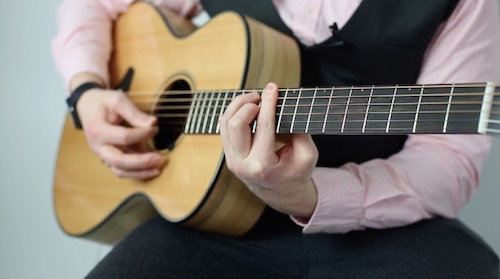
Barre Chords Technique Hi, I'm Grey and this is Hub Guitar. Let's talk about the overall technique needed to successfully play barre chords. I'll preface this with saying that most beginners should avoid barre chords, for at least 6 months. It's a big obstacle to learn to play barre chords and it depends on your physical conditioning. There's alot of other things you can do instead while you work up the strength to play barre chords. A barre chord is when you use a single finger from the fretting hand, normally the index finger, and push down multiple strings at the same fret. One of the first barre chords that players usually encounter is the F major barre chord. And that's ironic because it's also a fairly difficult barre chord. This chord works by fretting across the entire first fret with the index finger, and then with the remaining fingers, you create an "E Major" chord shape. So if this is E Major--notice that I'm using middle, ring and pinky to create it-- and then it up one fret, and barre across the entire first fret. My students are sometimes surprised to find that as a guitar player, I don't usually play this chord in this way. I don't really like to barre chords in the open position. There's usually an easier way to play an F chord. And I like to play things the easy way. When you practice barre chords, you should start with the easiest ones and move your way towards the harder ones. That makes "F Major" a poor choice, because it's among the harder ones. Actually, barre chords are largely a function of strength. So practicing really hard barre chords will help you build that strength. But if no pleasant sound is coming from your guitar when you practice, you're not going to practice long. So what makes barre chords more easy to play? 1 - Barre chords in the center of the neck, around Fret X or so, will be easier. That's because the tension of a string feels lighter in the middle than it does at either end. 2 - Barre chords where the finger doing the barre is not responsible for pressing the middle strings are easier. For example, in the F major shape we talked about, that's easier than an F7. F7 requires us to lift up the finger on the fourth string, and now the barre is responsible for playing four strings instead of 3. And one of those four is in the middle and it's very hard to transfer the force from the barre into that string. 3 - Barre chords on a properly set up guitar are easier to play. If you spend less than $1,000 on your guitar and you did not have it set up by a professional before, chances are your guitar is not properly set up. Setup refers to the string height and all kinds of tiny little adjustments that are made by a professional to make the guitar easy to play. Only very expensive instruments will arrive from the factory set up properly. The rest will usually need adjustments. The store selling the instrument is supposed to do these adjustments. But they are often done hastily--if at all. 4 - Barre chords on a guitar with lighter strings will be easier. The strings are thinner and easier to push. 5 - Barre chords on a guitar with detuned strings are also easier. So you can actually tune down the pitch of every string by an equal amount. Now there will be a little bit more slack on the string length between the nut and the saddle, and thus the string is easier to push. So knowing what we now know, we can come up a practice routine that takes that into account. I'm going to go to the Xth fret and play a D major, and then switch that shape down one string to create a G minor. And that's a fairly easy motion; same shape. I'm going practice back and forth, making sure all of my notes are nice and clean and I'm pressing firmly. Then I'm going to slide that whole thing down one fret and repeat. Db Major and Gbmajor. And I can continue all the way down the neck. The frets are getting larger, and the strings are feeling tighter. Once I've mastered that, I can go back to the Xth fret and try it again with a harder chord progression, like D7 to G7. Now my barre has to do some of the notes in the middle of the chord on strings 34 and 5, so it's getting harder. And then I work my way back down. So that's it. If barre chords are difficult for you, find a way to make them as easy as possible. And practice them slowly, until they become more and more easy.
There are a few points about technique that are worth considering when playing barre chords. Barre chords often prove to be a stumbling block between the beginning and intermediate levels of playing guitar. When you can play barre chords accurately and cleanly, that will be a clear sign that you are moving into the intermediate level of guitar playing.
If you’re having trouble playing barre chords correctly, or want to improve them, read on.
Barre chords are much easier to play on some guitars than others. Why? A higher quality guitar, set up correctly, is simply easier to play. This difference is especially noticeable when attempting to push down all 6 strings at once.
Barre Chord Basic Technique
One Finger Barre
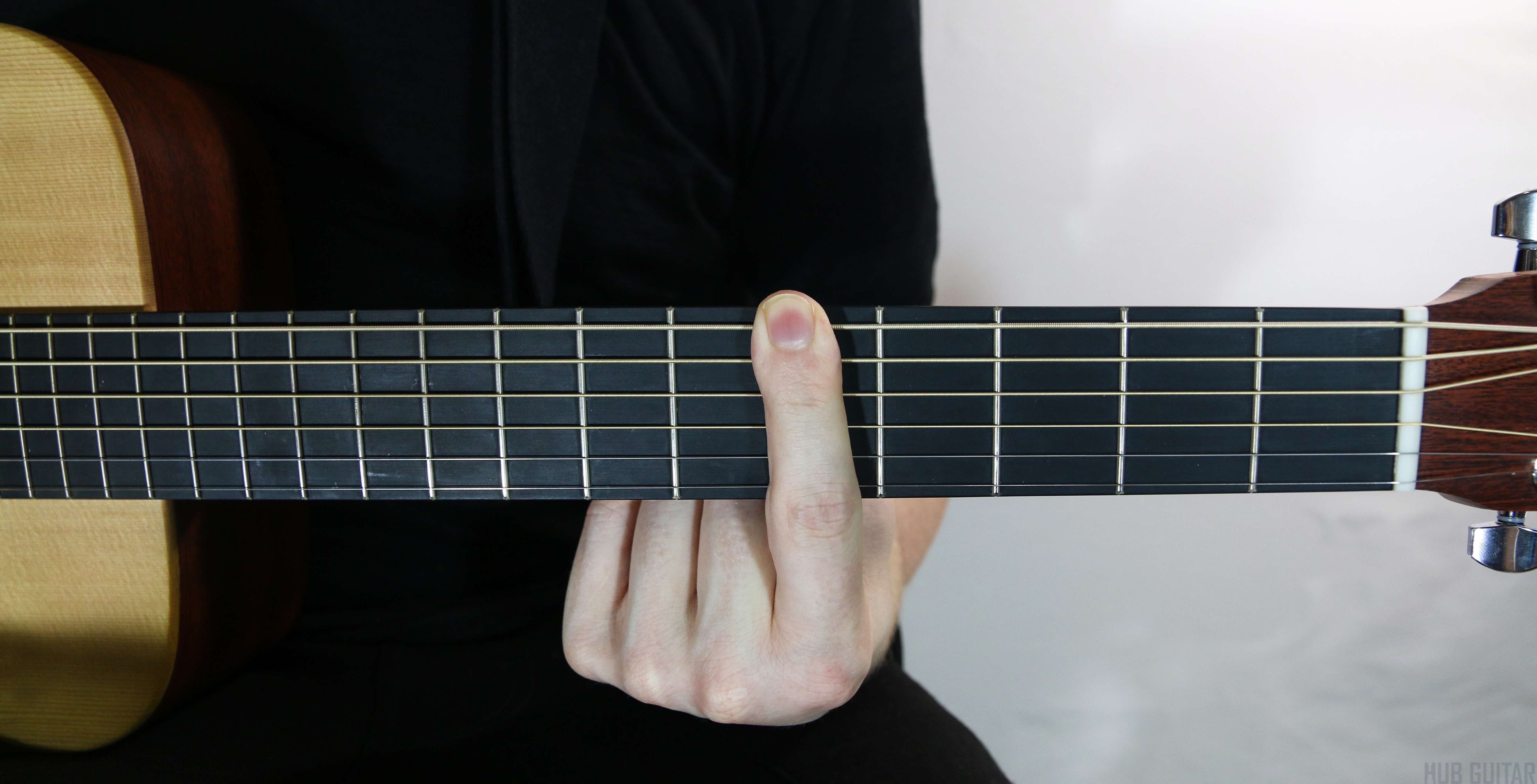
Practice playing barre chords first with a single finger. Barre all of the strings across fret five, and play each with your picking hand. The goal is to be able to play each string clearly.
Two Finger Barre
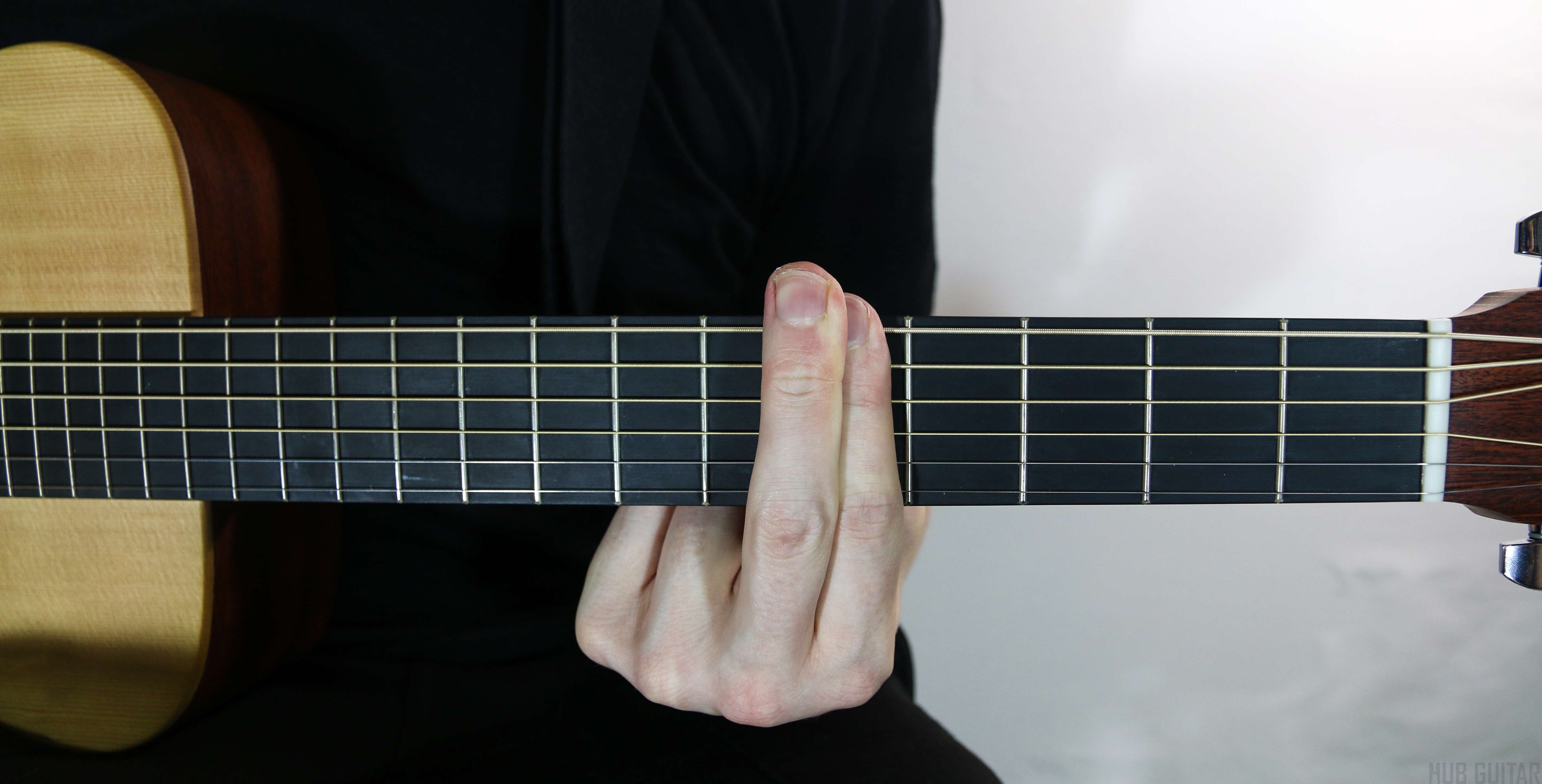
In some cases, you may have another finger available to use. In these cases, you can add that finger on top of the first finger for extra support. This leaves only two fingers for fretting any other necessary chord notes.
Thumb Support
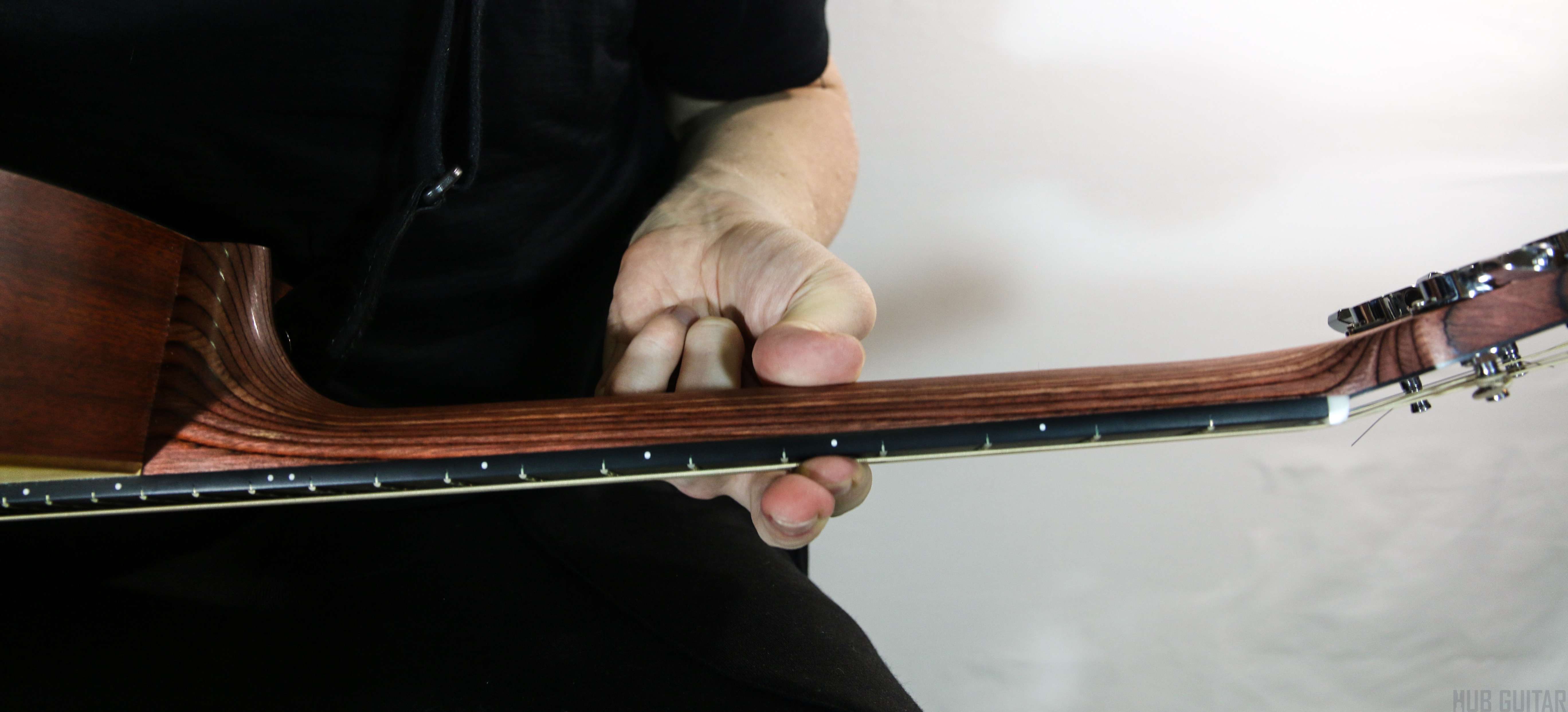
Be sure to enlist the support of the thumb of the fretting hand behind the neck of the guitar. Push it firmly into the back of the guitar neck, using as much surface area of the thumb as possible to transfer energy to the barre.
Hand Strength
As your hands get stronger, playing the barre chords will be easier. What was once impossible will become nearly effortless. For this reason, any hand-strengthening practice you do on the guitar may contribute to you learning the barre chords faster.
Barre Chord Tip #1: Hold the Guitar Correctly
Many players don’t realize the importance of holding the guitar properly. It is possible to hold the guitar in a way that adds a great deal of support to the fretting hand, by pivoting the instrument off of the sternum and applying leverage that pushes the neck of the guitar into the fretting hand. Rather than pushing your finger into the fretboard, you’re pushing the fretboard into your fingers!
Barre Chord Tip #2: Prioritize the Strings that Need to Ring
Example Barre Chord
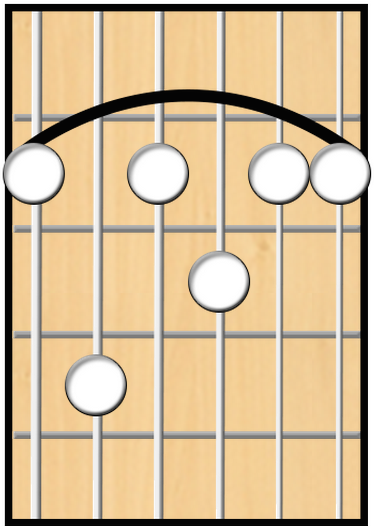
Let’s consider this dominant chord shape. The index finger barre is needed to play multiple notes. The index finger can easily push the frets on the 1st and 2nd strings because they are small and light. And it’s easy on the last string because that’s the end of the barre. It’s the middle note on the “D” string that is most difficult. That’s because this note has to be played by the barre, and it’s right in the center where the strength of the barre finger is at its lowest.
The notes on the “A” and “G” strings are going to be pressed down by other fingers. So the main job of the barre is to play that note on the “D” string. In a way, that means any additional strength added to the finger barre should be focused on the point above the D string.
Be sure that the string is not passing underneath the crease of the finger underneath the knuckle joint; this would mean you'd have to push even harder to barre successfully.
Barre Chord Tip #3: Play Lots and Lots of Power Chords
In some ways, power chords are the precursor to barre chord technique as they start to demand a higher level of wrist strength. Before you bother playing barre chords, you should be pretty comfortable playing constant power chords for 5 or even 10 minutes at a time.
This works both for 2-string power chord shapes as well as 3-string shapes.
Barre Chord Tip #4: Get a Better Guitar
If your guitar is crap, you can probably play some open chords, some scales, some basic songs. But if it isn’t any good, you’re really going to start feeling that as soon as you try to tackle harder chords like barre chords.
The feeling of a nice guitar in your hands is partially subjective, but you can be sure that more money will get you a guitar that plays better—to a point. (About $1000 for electric guitars and $1750 for acoustic guitars is where that point usually ends, by the way)
This is not to discourage learners from playing on whatever instrument that they have available, but a reminder that if you really want to learn, get the best guitar you can. Even if you have to take out a loan to buy a good instrument.
Barre Chord Tip #5: Lower Your Action
Some guitars really aren’t easy to play a barre chord on. If you haven’t had your guitar set up before, or recently, it’s a good idea to do this.
During a setup, you can make sure the action is as low as it will go. This will make playing barre chords much easier. This is done by adjusting the height of the saddleThe small ivory or cream colored piece of the guitar, mounted on the bridge, on the body of the guitar. This is the part on which the tightened strings rest, and are elevated above the body of the guitar. and also the depth of the slots carved into the nut.
Barre Chord Tip #6: Get Lighter Strings
If you’re stilling having problems, consider getting lighter strings: Elixir Nanoweb Acoustic Coated Strings (Light)[?]Affiliate Link These are easier to push down, so they’re easier to barre. It’s that simple.
Barre Chord Tip #7: Detune Your Guitar
A quick (and cheap) trick to make your guitar easier to play is to detune the strings. This will lower the tension on the strings and make them easier to push down. You can tune down a half-step, but the effect is not dramatic. Tuning down a full whole step will work on most guitars, and chords will get much easier.
| Standard Tuning | E | A | D | G | b | e |
| Drop-Step Tuning | D | G | C | F | a | d |
| Difference | -2 | -2 | -2 | -2 | -2 | -2 |
Barre Chord Tip #8: Start Practice at Fret X
The guitar string tension is lowest in the middle of the string, around Fret X, than it is at the end of the string, at Fret I. So start practicing your barre chord shapes in the middle of the neck, and progressively move them back towards Fret I. They will get noticeably more difficult as you approach the Ist fret.
Coda
Barre chords are a stumbling block for many learners. If this problem is affecting you, don’t get discouraged! Go around. Find some other area that you can work on. Gradually, you’ll be able to build your strength to the point where you can play barre chords easily.
 As the creator of Hub Guitar, Grey has compiled hundreds of guitar lessons, written several books, and filmed hundreds of video lessons. He teaches private lessons in his Boston studio, as well as via video chat through TakeLessons.
As the creator of Hub Guitar, Grey has compiled hundreds of guitar lessons, written several books, and filmed hundreds of video lessons. He teaches private lessons in his Boston studio, as well as via video chat through TakeLessons.